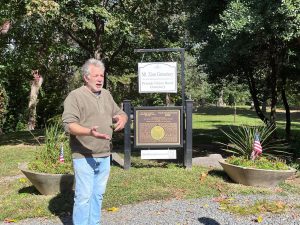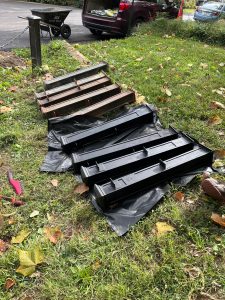As Georgetown remains one of the District’s most popular tourist destinations, the Mount Zion-Female Union Band Society Cemeteries serve as a reminder of the rich African-American history of the neighborhood.
This is a result of preservation efforts undertaken by the Black Georgetown Foundation, formerly known as the Mount Zion-Female Union Band Society Historic Park Foundation, which manages the preservation and commemoration of the burial ground.

The foundation’s primary aim is to memorialize the grounds because of its historic significance: a burial ground for people who were born and died enslaved. It houses a cemetery vault that may have served as a station on the Underground Railroad.
The group’s most recent event was held Oct. 21, an afternoon dedicated to preservation and restoration activities at the cemetaries.
Lawana Holland-Moore, the director of fellowships and interpretive strategies for the African American Cultural Heritage Action Fund at the National Trust of Historic Preservation, said that many sites related to African-American history have often been obscured or omitted.
“Mount Zion, for instance, is one of the last remnants of black Georgetown,” Holland-Moore said.
In February, on the 215th anniversary of the founding of the burial grounds, the D.C. Council passed a resolution to commemorate the cemeteries.

“The community often knows about it, as these places are important to them, but it becomes a matter of bringing visibility to that site in a way that others know about that importance too,” said Holland-Moore.
“We’re a UNESCO site, a site of memory for the slave trade and the Underground Railroad,” said Patrick Tisdale, a volunteer at Black Georgetown Foundation who has been working for four years to transform the African American burial ground into a memorial.
Tisdale said it is important not just to promote the cemetery as a piece of history but to establish its identity.
At the Oct. 21 event, volunteers helped clean up debris, weed areas around headstones, clear out leaves, branches and soil from the roof of the cemetery vault, top fresh soil, spread grass seeds, and sand and paint salvaged iron posts for demarcations.

Holland-Moore said that as neighborhoods change, community histories become lost.
“You might have people who are brand new to the city, as is often the case in D.C., who have no idea about the history of who once was in that community,” said Holland-Moore.
“There’s a commonality that we can find in these spaces,” said Holland-Moore. “These are special places that should be protected for generations to come.”
Tisdale stood by the signage, tucked between the apartments at Q and 27th streets, talking about the cemetery.
“There’s a greater focus and an interest in the real history of the United States now, which includes a real accounting and a whole accounting for the Black history of Georgetown, DC,” said Tisdale.

The foundation calls for monetary contributions and volunteerism through the upkeep of the property, preservation of artifacts, recording historical data, and serving as unofficial tour guides for guests. They also work with cemetery property surveys, maintenance of the grounds in terms of cleanliness and pruning of trees and genealogical research.
Georgetown resident Erin Zielinski started volunteering at the Congressional Cemetery, located on the West Bank of the Anacostia River on Capitol Hill. She later started volunteering at Mt. Zion where she is currently working on iron posts that would demarcate public land from the cemetery.
“The garbage trucks would back into the grounds on graves and get stuck,” said Zielinski about the iron posts. “Imagine that, people are buried there, and so we put up posts to protect.”
Zielinski said it was important to honor Black history the way the city worked to restore other aspects of American history.
“These were all people too,” Zielinkski said. “We may not have known them, but they matter to someone.”
In 2021, the National Park Service wanted to replace an old bike trail in Rock Creek Park. The NPS is obligated by law to inform adjoining property owners of the project.

“They were using maps and documents that they had and they referred to Mount Zion as ‘colored cemeteries’ with no contact details and no address,” said Tisdale.
Lisa Fager, the executive director of Black Georgetown Foundation, said in a statement that she intervened and issued a stop work order that cordoned off the area.
“We had to put an injunction down for six months until they got an archaeologist to come to scan the grounds and then archaeologists worked with them once they took the dirt off inch by inch,” said Tisdale.
NPS did not respond to a comment on this story.
The foundation hosts regular events where volunteers are welcome to participate in preservation and restoration activities. The foundation also hosts a series of workshops, tours and other recreational projects that teach volunteers about restoration and repair work for delicate historical artifacts.















Add comment